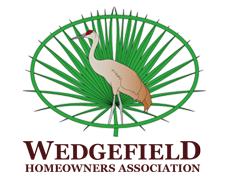“Plant a Seed and Grow a Friendship”
 The Group Objective is to create, promote and develop an interest in gardening by sharing knowledge and experience. Feel free to participate by posting your gardens ideas, tips, project and questions on our Facebook page. We are always willing to learn new ways to keep our garden growing.
The Group Objective is to create, promote and develop an interest in gardening by sharing knowledge and experience. Feel free to participate by posting your gardens ideas, tips, project and questions on our Facebook page. We are always willing to learn new ways to keep our garden growing.
https://www.facebook.com/groups/419131141784330/
Who: Anyone interested in gardening and plants are welcome to attend!
What: Sharing gardening and plant information, educational speakers, educational field trips, lunch with friends.
Where: Wedgefield Club House Conference Room
When: The first Thursday of every month at 11:0 am
The Garden Club meets on July 5th at 10:45 at the Wedgefield Golf Club. There were three visitors who contributed several helpful hints such as adding a few drops of Dawn dish soap to a quart or so of water and spraying to keep the insect population down.The program was hosted by Sylvia Cox as she elaborated on her favorite plants in her yard. Some of the plants she talked about were:
Canna Lily – Exotic, tropical creatures, cannas need lots of sunshine and fertile, moist soil—but you don’t have to pamper them. Cannas do best with a good supply of water, so water the plants during the summer if the rainfall is less than 1 inch per week. Water freely in a dry spell. As flowers fade, deadhead to promote continued flowering. After the flower stem has been deadheaded several times and is no longer producing flowers, cut the flower stem and any attached foliage to the ground, as this can help nearby cannas get more light and flower themselves.
Caladiums – Caladium leaves can be shaped like hearts, arrows, or lances in color combinations of red, pink, rose, white, chartreuse, and green. Always water caladiums regularly. Keep the soil slightly moist. Add mulch, such as pine straw, to help retain soil moisture and conserve water. If you have caladiums in full sun, don’t let them dry out.
Allamanda – A tropical twining vine with deeply veined, whorled leaves and large, trumpet-shaped bright yellow flowers. Prickly seed pods follow the flowers with winged seeds that fly about when the pod dries and breaks open. Allamanda is perennial in tropical climates and may be treated as an annual or brought inside during cold weather and replanted after danger of frost. The plant is often pruned and used as a shrub. Grows well in most soils, but becomes chlorotic in very alkaline conditions. Train up a trellis, tree, or side of a building where there is support, or prune and maintain as a shrub.
Knockout roses – The Knock Out roses are easy to grow, not requiring much care. They are also very disease resistant, too, which adds to their appeal. Their bloom cycle is about every five to six weeks. The Knock Out roses are known as“self-cleaning” roses, so there is no real need to deadhead them. When caring for Knock Out roses, feeding them a good organic or chemical granular rose food for their first spring feeding is recommended to get them off to a good start.
After her presentation members played a game (we’re not all serious!) to win plants given by Sylvia Cox. Members discussed various favorite blooming plants and named a few birds that have been spotted around Wedgefield. We are so lucky to have natural wildlife here in our beautiful area!
****You may also get assistance at the IFAS Extension where Master Gardeners are available from 8 am-noon and 1- 5 pm weekdays; or call 407-254-9200.
[/one_half_last]


